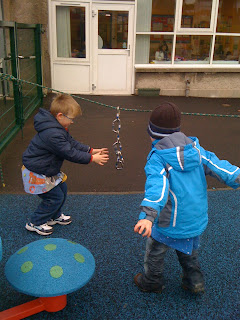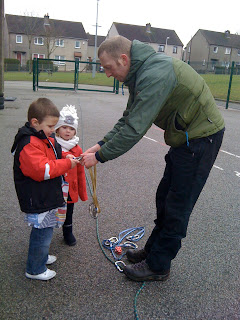The use of a big old climbing rope was an experiment for me. Just over a year ago I thought I would see what would happen if pre-school children started playing with a rope. The health and safety paranoid queen that lurks within me catastrophised like crazy…
“They will trip up. They simply won’t notice the rope.
It will get wrapped around their legs, or even their necks.
Oh no! Rope burn! 20 pairs of red raw hands. Do I have enough bandages?
The ends will flick into their eyes. Permanent damage will happen. I will not be forgiven.”

So with shaking legs and a brave heart, I ventured into a nursery with the rope in a bag. We talked about the rope and what we’d need to remember when playing outside with it. And we went outside and played. And played. And played.
Sometimes the children do stand on the rope and this can be a game in itself. Wrapping the rope around trees and other objects is always an interest. The children know not to wrap it around themselves or each other.
Just holding onto part of the rope and feeling it move, is surprisingly popular. In the photo below, the children seemed to naturally work in pairs to work a rope.
Pulling, shaking and waving a rope are all “must-do” experiments for children. The rope can be tied to an object such as a fence post if necessary.

A rope attached above the children’s heads or near head height is great for a different pulling and pushing experience.

Next it’s time to bring out the karabiners. The bigger the ‘biner the better! Hearing the karabiners click and working out what they can do is fascinating for children.
Pretty quickly, chains are made which can be hung in different places, including on the rope.

And of course, buckets can be attached. The girl in the photo below actually got into the bucket but didn’t know how to move herself.

Karabiners can be attached to fencing and used in many different ways.

Add in some slings and further experiments begin.

Such as trying to move tyres in different ways.

I chose to use an old climbing rope for several reasons. It is really long at 50m. Most DIY shops sell shorter lengths of rope. The texture and feel of a climbing rope is different to hemp or blue rope. It has more give, feels softer and is more pliable.
It is important that pre-school practitioners and children know that an old climbing rope should not be used for weight bearing such as climbing or load bearing activities like towing a car. It should only be used under direct adult supervision for play purposes.
The longevity of a discarded climbing rope can be enhanced by ensuring it is dried away from direct heat after becoming wet, kept free of knots between sessions and resealed when frayed. Most outdoor shops offer this service. When the rope is beyond use for play purposes, seek advice about disposing of it safely. Again, an outdoor shop should be able to advise.
Oh, and the paranoid health and safety queen within me also tells you that this post is for information only and is not a guide to using a climbing rope. Eek!
PS This is the second part based upon activities undertaken during the Outdoor Nurture Project run by Aberdeen City Early Years team. Thanks Sue Thorburn for having the innovation, imagination and determination to set it up and get it going! Thanks to Richard Lawes from Adventure Aberdeen for reassuring me about the use of discarded ropes and looking after them.




















oh I laughed at the “paranoid health and safety queen within me” comment! I’m going to start discribing myself as that sometimes!…because just the photos made me a bit nervous!! (although I really like the idea of hooking up buckets to deliver things.)